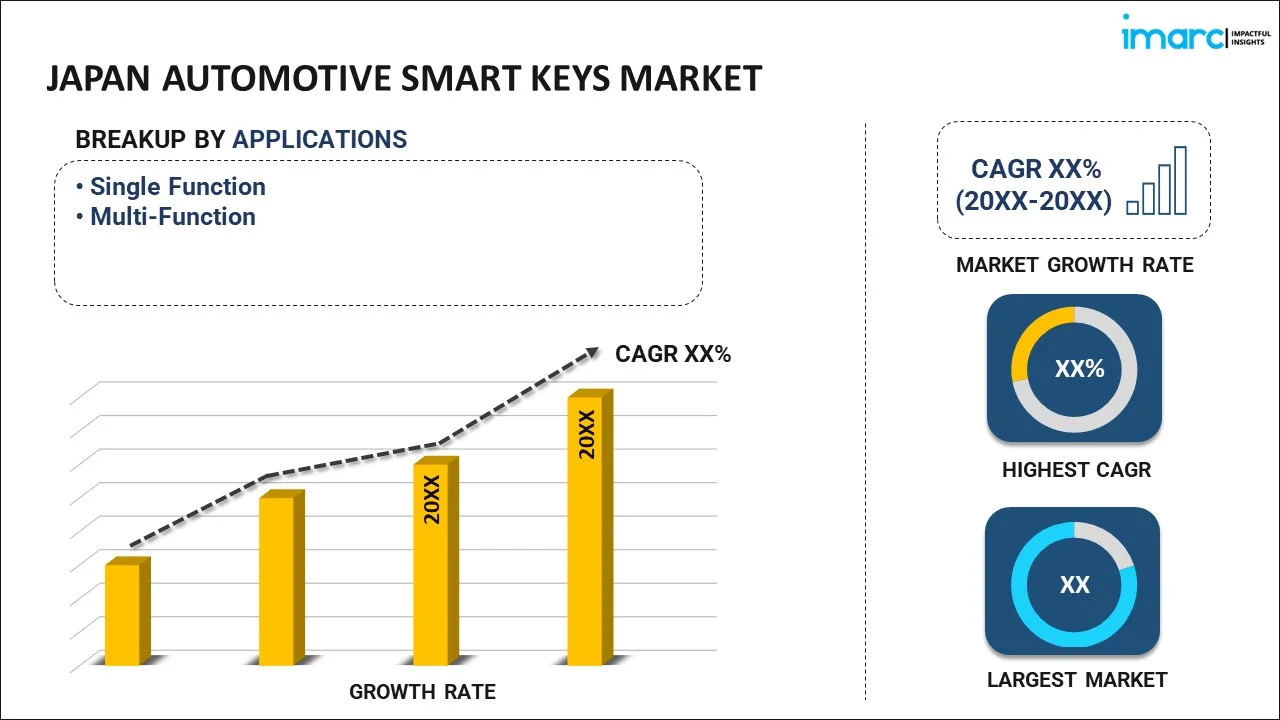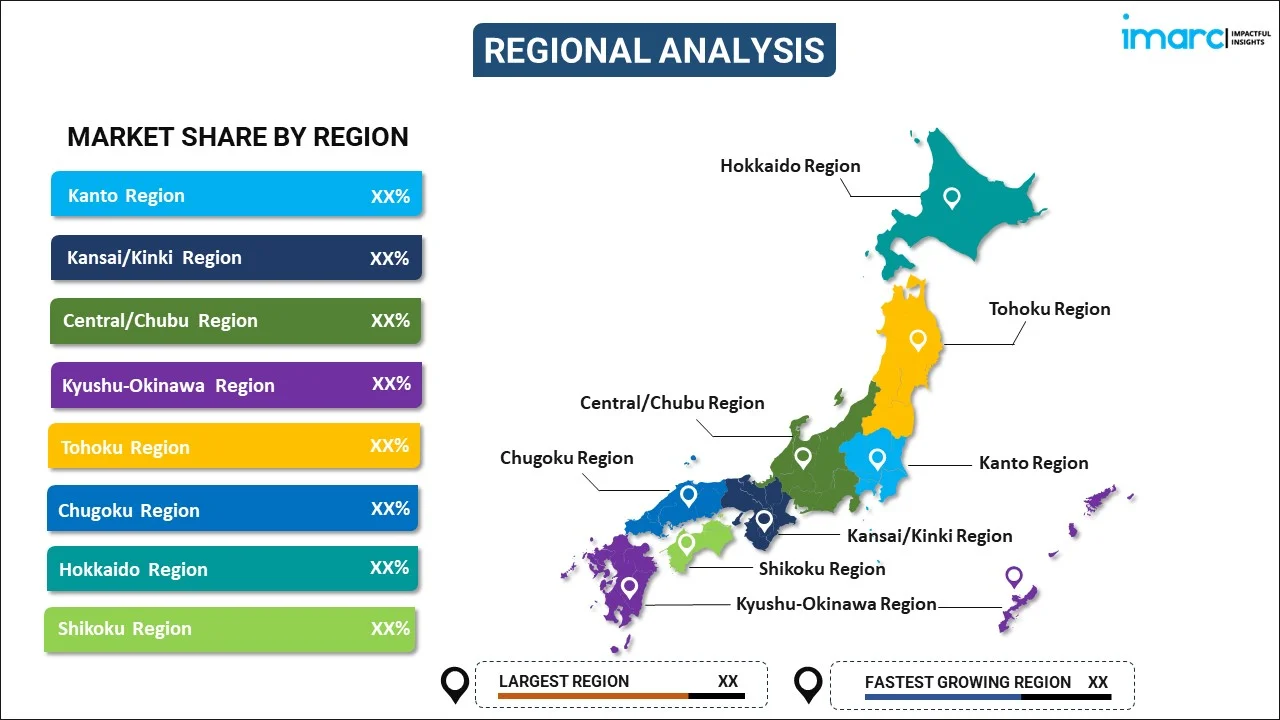
Japan Automotive Smart Keys Market Report by Application (Single Function, Multi-Function), Technology (Remote Keyless Entry, Passive Keyless Entry), End User (OEM, Aftermarket), and Region 2025-2033
Market Overview:
Japan automotive smart keys market size reached USD 422.4 Billion in 2024. Looking forward, IMARC Group expects the market to reach USD 948.2 Billion by 2033, exhibiting a growth rate (CAGR) of 8.6% during 2025-2033. The increasing demand for enhanced security, convenience, and connectivity features in modern vehicles that can improve the overall driving experience is primarily driving the automotive smart keys market in Japan.
|
Report Attribute
|
Key Statistics
|
|---|---|
|
Base Year
|
2024
|
|
Forecast Years
|
2025-2033
|
|
Historical Years
|
2019-2024
|
|
Market Size in 2024
|
USD 422.4 Billion |
|
Market Forecast in 2033
|
USD 948.2 Billion |
| Market Growth Rate 2025-2033 | 8.6% |
Automotive smart keys have revolutionized vehicle access by offering a level of convenience and security unparalleled by traditional mechanical keys. These intelligent devices, utilizing advanced encryption technologies, allow users to unlock and ignite their vehicles without direct physical contact with the key, typically relying on radio frequency identification (RFID) or infrared signals. By simply having the smart key in proximity to the vehicle, users can unlock doors and start the engine with the press of a button, streamlining the interaction between the driver and the vehicle. As the automotive industry continues to embrace technological advancements, smart keys have become synonymous with modern driving experiences, enhancing not just user convenience but also incorporating features like remote start, vehicle tracking, and personalized setting adjustments, which cater to a driver's individual preferences and needs.
Japan Automotive Smart Keys Market Trends:
The automotive smart keys market is experiencing substantial growth, driven by various regional market dynamics. Firstly, the advancement and incorporation of cutting-edge technology have been pivotal, with the proliferating demand for connected cars serving as a precursor for market expansion. Additionally, the escalating emphasis on vehicle security has propelled manufacturers to integrate sophisticated features in smart keys, such as biometric recognition and advanced encryption, fostering market development. Secondly, rising consumer preference for convenience and enhanced vehicle functionality is acting as a catalyst, triggering the accelerated adoption of smart keys in Japan. For instance, features like keyless entry and ignition have become essential requirements for many consumers, thereby elevating the market's trajectory. Furthermore, the augmentation in automobile sales, notably in emerging economies, is contributing significantly to the demand for automotive smart keys. Moreover, numerous government regulations advocating for advanced vehicle security solutions are bolstering the adoption of these intelligent systems. Additionally, the evolving automotive landscape marked by the influx of electric and hybrid vehicles has necessitated the development of compatible smart keys, thereby providing an impetus to automotive smart keys market growth in Japan.
Japan Automotive Smart Keys Market Segmentation:
IMARC Group provides an analysis of the key trends in each segment of the market, along with forecasts at the country level for 2025-2033. Our report has categorized the market based on application, technology, and end user.
Application Insights:

- Single Function
- Multi-Function
The report has provided a detailed breakup and analysis of the market based on the application. This includes single function and multi-function.
Technology Insights:
- Remote Keyless Entry
- Passive Keyless Entry
A detailed breakup and analysis of the market based on the technology have also been provided in the report. This includes remote keyless entry and passive keyless entry.
End User Insights:
- OEM
- Aftermarket
A detailed breakup and analysis of the market based on the end user have also been provided in the report. This includes OEM and aftermarket.
Regional Insights:

- Kanto Region
- Kansai/Kinki Region
- Central/ Chubu Region
- Kyushu-Okinawa Region
- Tohoku Region
- Chugoku Region
- Hokkaido Region
- Shikoku Region
The report has also provided a comprehensive analysis of all the major regional markets, which include Kanto Region, Kansai/Kinki Region, Central/ Chubu Region, Kyushu-Okinawa Region, Tohoku Region, Chugoku Region, Hokkaido Region, and Shikoku Region.
Competitive Landscape:
The market research report has also provided a comprehensive analysis of the competitive landscape. Competitive analysis such as market structure, key player positioning, top winning strategies, competitive dashboard, and company evaluation quadrant has been covered in the report. Also, detailed profiles of all major companies have been provided.
Japan Automotive Smart Keys Market Report Coverage:
| Report Features | Details |
|---|---|
| Base Year of the Analysis | 2024 |
| Historical Period | 2019-2024 |
| Forecast Period | 2025-2033 |
| Units | Billion USD |
| Scope of the Report | Exploration of Historical Trends and Market Outlook, Industry Catalysts and Challenges, Segment-Wise Historical and Future Market Assessment:
|
| Applications Covered | Single Function, Multi-Function |
| Technologies Covered | Remote Keyless Entry, Passive Keyless Entry |
| End Users Covered | OEM, Aftermarket |
| Regions Covered | Kanto Region, Kansai/Kinki Region, Central/ Chubu Region, Kyushu-Okinawa Region, Tohoku Region, Chugoku Region, Hokkaido Region, Shikoku Region |
| Customization Scope | 10% Free Customization |
| Post-Sale Analyst Support | 10-12 Weeks |
| Delivery Format | PDF and Excel through Email (We can also provide the editable version of the report in PPT/Word format on special request) |
Key Questions Answered in This Report:
- How has the Japan automotive smart keys market performed so far and how will it perform in the coming years?
- What has been the impact of COVID-19 on the Japan automotive smart keys market?
- What is the breakup of the Japan automotive smart keys market on the basis of application?
- What is the breakup of the Japan automotive smart keys market on the basis of technology?
- What is the breakup of the Japan automotive smart keys market on the basis of end user?
- What are the various stages in the value chain of the Japan automotive smart keys market?
- What are the key driving factors and challenges in the Japan automotive smart keys market?
- What is the structure of the Japan automotive smart keys market and who are the key players?
- What is the degree of competition in the Japan automotive smart keys market?
Key Benefits for Stakeholders:
- IMARC’s industry report offers a comprehensive quantitative analysis of various market segments, historical and current market trends, market forecasts, and dynamics of the Japan automotive smart keys market from 2019-2033.
- The research report provides the latest information on the market drivers, challenges, and opportunities in the Japan automotive smart keys market.
- Porter's five forces analysis assist stakeholders in assessing the impact of new entrants, competitive rivalry, supplier power, buyer power, and the threat of substitution. It helps stakeholders to analyze the level of competition within the Japan automotive smart keys industry and its attractiveness.
- Competitive landscape allows stakeholders to understand their competitive environment and provides an insight into the current positions of key players in the market.
Need more help?
- Speak to our experienced analysts for insights on the current market scenarios.
- Include additional segments and countries to customize the report as per your requirement.
- Gain an unparalleled competitive advantage in your domain by understanding how to utilize the report and positively impacting your operations and revenue.
- For further assistance, please connect with our analysts.
 Inquire Before Buying
Inquire Before Buying
 Speak to an Analyst
Speak to an Analyst
 Request Brochure
Request Brochure
 Request Customization
Request Customization




.webp)




.webp)












